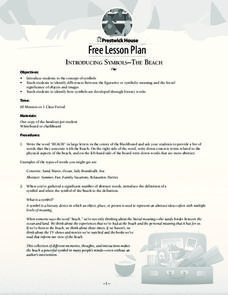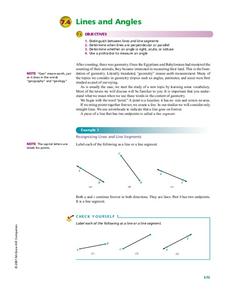Curated OER
Use of the Verb "Keep"
In this phrasal verb worksheet, students write translations for different meanings of the verb "keep", complete sentences and make up new ones with "keep".
Curated OER
Charades
Fourth graders play a game. In this vocabulary lesson, 4th graders play the game Charades to help review their vocabulary words. At the end of the lesson students can create their own words to act out.
Curated OER
Introduce -ed = /d/, -ed = /t/ Words
First graders explore word structure by participating in a phonics activity. For this word ending lesson, 1st graders discuss the -ed endings to many words and practice sounding out words with that ending. Students identify the changes...
Curated OER
Introduce -ed = /d/, -ed = /t/ words
First graders are introduced to word endings and sounds. In this word accuracy lesson, 1st graders practice identifying, writing, and saying -ed words.
Curated OER
Spelling Practice: ow and ou Words
Fifth graders complete activities for ou and ow words. In this ou/ow words activity, 5th graders practice ou and ow words by completing the 'instant activity.' Students complete a crossword puzzle activity for ou and ow words.
Prestwick House
Introducing Symbols–The Beach
Looking for a way to introduce class members to the concept of symbolism and multiple levels of meaning? Readers examine two different passages about the beach and consider how the writers use concrete objects, and places to represent...
K12 Reader
Geometric Shape Names
Combine math and language arts in the same lesson with a reading passage about number prefixes in geometric shapes. After reading several short paragraphs about the different prefixes used in shape names, kids answer five comprehension...
Have Fun Teaching
Context Clues (5)
Unfamiliar words can make it difficult to understand what a piece of writing is trying to say. Practice using context clues to define words you don't know with a language arts learning exercise, which features five sentences and enough...
Winterhill School
Poetry Analysis
Gain greater insight into poems using a poetry analysis learning exercise. Here, scholars follow steps and answer questions to dissect any poem. Topics include the poem's meaning, theme, technique, and structure, as well as personal...
Curated OER
Synonym Trees
Pair learners to define synonyms. They search flash cards to find a synonym partner. Then they chart pairs of synonyms on a synonym tree.
K12 Reader
Antonyms are Opposites
Knowing the opposite of your chosen word is a great step in improving your word choice. Young readers select an antonym from the provided word bank to complete a series of 14 sentences.
Curriculum Corner
“I Can” Common Core! 1st Grade Language
Support first graders with developing their basic language skills using this Common Core checklist. With each standard rewritten as a positive I can statement, students are encouraged to work hard toward reaching these clear learning...
National Christmas Tree Association
Merry Christmas, Geraldine
If you're reading the story "Merry Christmas, Geraldine" by Holly Keller, this is a fantastic cross-curricular resource to use. Complete with activities for language arts, science, social studies, art, and math, you'll get the most out...
Shoop English
Literature Terms Activity
Designed to be used with an independent reading book, this activity provides practice with identifying and explaining literary terms. While they read, individuals find instances of literary devices and elements in use in their books....
Curated OER
Dilworth Elementary Character Education Respect (September)
R-e-s-p-e-c-t, find out what it means to your class! After a grand conversation about what is, and how one can show respect, scholars take part in a plethora of activity choices such as role playing, a game of Simon Says, wood working,...
K12 Reader
The Grand Canyon
After reading s short description of the Grand Canyon, readers demonstrate their ability to use context to determine the meaning of words in the passage.
Prestwick House
Teaching Shakespeare: Sonnet 73
It's that time of year to consider how Shakespeare selects his images and structures his Sonnet 73 to develop the meaning of the poem. Class members examine the rhyme scheme, the indented lines, the conceit, and the images used in each...
Poetry4kids
How to Write a Diamante Poem
A lesson begins with a description of a diamante poem and the rules to follow while writing one. Scholars examine the ins and outs of synonym and antonym diamantes, then compose an original poem using their newfound knowledge.
For the Teachers
Cause and Effect Matrix
Study cause and effect in both literature and informational text with a lesson designed for several different reading levels. After kids review the concept of cause and effect, they read an article or story and note the causes and...
McGraw Hill
Lines and Angles
Why was the obtuse angle upset? Because it was never right! A valuable resource is loaded with background information on types of angles and lines. Learners review the characteristics of parallel, perpendicular, and intersecting lines,...
Curated OER
Introducing Synonyms to Early Writers
Upper elementary schoolers examine the concept of synonyms and how using a variety of vocabulary through synonyms can expand their writing skills. They revise a paragraph using synonyms located on the Visual Thesaurus and participate in...
Statistics Education Web
It’s Elemental! Sampling from the Periodic Table
How random is random? Demonstrate the different random sampling methods using a hands-on activity. Pupils use various sampling techniques to choose a random sample of elements from the periodic table. They use the different samples to...
Curated OER
Using Por and Para
Clear up confusion around por and para. These words can be very difficult, especially for learners who are native English speakers. The information section describes when to use each word and provides examples of specific situations....
Science Matters
Earthquakes and Volcanoes Pre-Assessment
See how much your class knows about earthquakes and volcanic activity and how these events shape geologic features. The first lesson in the series of 20 is a pre-test to find out what pupils already know. It includes 10 vocabulary words...

























